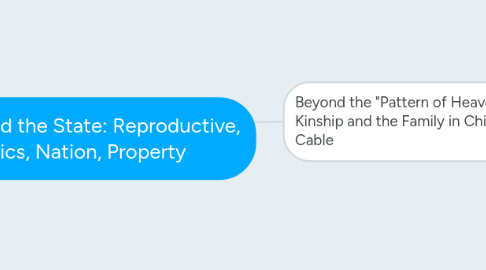
1. Beyond the "Pattern of Heaven": Gender, Kinship and the Family in China by Monica Cable
1.1. Ethnic Groups
1.1.1. 92% Han
1.1.1.1. NOT homogenous
1.1.1.2. Represents one of the most male-centric kinship systems, but there are also important distinctive practices and differences in the minority groups
1.1.2. 8% divided among 55 different minority groups
1.1.2.1. Minority groups considered to be "Chinese" but have traditions, and practices that deviate drastically from those of the Han.
1.2. Explores the interrelationship between gender, kinship and the family.
1.2.1. "Chinese culture, should be more correctly termed Han Chinese culture
1.3. The Han Chinese
1.3.1. Several smaller kingdoms were united, along with the establishment of a written language in the Han dynasty of 206 BC - 220 AD.
1.3.2. Two important factors that unite the heterogeneous Han group
1.3.2.1. Confuianism
1.3.2.1.1. Founded by Kong Fuzi "Confucius" in 6th century BC.
1.3.2.1.2. An open system, anyone you wants to join, may join
1.3.2.1.3. primary tenet is filial piety
1.3.2.1.4. Important emphasis on five relationships, wu lun
1.3.2.2. Patrilineal Kinship
1.3.2.2.1. In the extensive male network, woman are only seen as a means to propagate the lineage is considered a major factor in the low status of Han Chinese women.
1.3.3. The Surname
1.3.3.1. Maintains the importance of the Han Chinese patriline that is reflected in the Chinese kinship terms and the strict rules of surname exogamy
1.3.3.1.1. Kinship for father's side extensive, and vague and lumped together for the mother's side.
1.3.4. Life Stages of the Han Chinese Woman
1.3.4.1. Tradition place the female in an extremely inferior position.
1.3.4.1.1. Subordinate position, where they are required to defer to the men throughout their lives beginning with their father, then husbands, and then sons
1.3.4.1.2. From birth, girls are at a disadvantage
1.3.4.2. Most important stage of her life is Marriage
1.3.4.2.1. Woman becomes the property of her husband
1.3.4.2.2. Divorce is the worst thing possible, woman not secure until she produced a son.
1.4. Nuanced Approaches to Han Chinese Gender and Kinship
1.4.1. Record is male-centric
1.4.2. uterine family, a mother-centered family unit that could serve to support women cut off from their natal kin networks.
1.4.2.1. Confucius element is that the mother needs to stress the idea of filial piety
1.4.2.2. Key relationships are between the mother and her sons, a structure that makes the daughter-in-law a potential danger to the mother.
1.5. Post-1949 trends
1.5.1. Intertwining relationships between kinship, gender, and the family have been affected by changes in China, since the founding of the republic
1.5.1.1. Chinese Communist Party
1.5.1.1.1. gave women de jure equality, such as the right to divorce
1.5.1.1.2. Religions were repressed and slowly disappeared
1.5.1.1.3. One-child policy
1.6. Alternate Models of Kinship and the Family in China
1.6.1. The Dai
1.6.1.1. kinship is bilateral
1.6.1.1.1. no corporate lineages, lack surnames
1.6.1.2. Matrilocal post-marriage residence pattern
1.6.1.2.1. husbands move into their brides home and provide labor for the womans family
1.6.1.3. Male or female can request a divorce
1.6.1.4. Parents change name based on the birth of their eldest child
1.6.2. The Lahu
1.6.2.1. High degree of gender equality
1.6.2.1.1. High value on gender unity, work in teams
1.6.2.2. show no preference for male or female children
1.6.2.3. Kinship is bilateral
1.6.3. The Mosuo
1.6.3.1. Matrilineal group
1.6.3.1.1. Practice a unique form of male/female pairing
1.6.3.1.2. Distinct sexual division of labor
1.7. Conclusion
1.7.1. The Chinese Majority
1.7.1.1. Han
1.7.1.1.1. Characterized by a heavily patrilineal system in which women at first glance have no other role than to bear children for their husband lineage.
1.7.2. The Chinese minority
1.7.2.1. Constitute over 100 million people with diverse kinship systems and gender relationships
1.7.3. Obviously diverse traditions fall under the category of "Chinese"
1.7.3.1. That is more variation in tradition and kinship in China than is usually depicted by scholars
